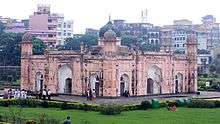Pari Bibi
Pari Bibi was a Mughal Princess and the daughter of Shaista Khan. She was the wife of Prince and future Mughal Emperor Muhammad Azam Shah.[1] She is the grandniece of Nur Jahan the main consort of Mughal Emperor Jahangir.[2]
Biography
Pari Bibi was the daughter of Shaista Khan and was also known as Iran Dukht Rahmat Banu. She was married to Muhammad Azam, the son of Mughal Emperor Aurangzeb, on 3 May 1668. She lived in Dhaka, Bengal Subah (province), her father was the governor of the province. Mughal records of that era showed that she played an influential role in the governor household and the politics of the province.[3]

Death and tomb
In 1678 Pari Bibi died a premature death and left her father heartbroken. Shaista Khan was constructing the Lalbagh Fort in Dhaka, the construction of the fort had started under her husband Prince Muhhammad Azam. Shaista Khan now viewed the fort as inauspicious and stopped construction of the fort. He built the tomb of his daughter with the compound of the fort.[3] Other sources have reported that the tomb was constructed by Prince Azam himself.[4] The Tomb of Pari Bibi is considered an important architectural site in Dhaka, Bangladesh.[5] Since 1974 the Tomb of Pari Bibi and Lalbagh Fort has been managed by the Department of Archaeology.[6]
References
- "Legends of Lalbagh". The Daily Star. 12 June 2015. Retrieved 11 November 2017.
- Rahman, Syedur (2010). Historical Dictionary of Bangladesh. Scarecrow Press. p. 87. ISBN 9780810874534.
- Hossain, AKM Yakub; Chowdhury, AM. "Bibi Pari". en.banglapedia.org. Banglapedia. Retrieved 11 November 2017.
- Ray, Aniruddha (2016). Towns and Cities of Medieval India: A Brief Survey. Taylor & Francis. p. 487. ISBN 9781351997317. Retrieved 11 November 2017.
- Ṣābir, Muḥammad Shafīʻ (1970). Pakistan: Culture, People & Places. University Book Agency. p. 386. Retrieved 11 November 2017.
- "The Myths of Lalbagh Fort". The Daily Star. 20 September 2013. Retrieved 11 November 2017.
| Wikimedia Commons has media related to Tomb of Pari Bibi. |